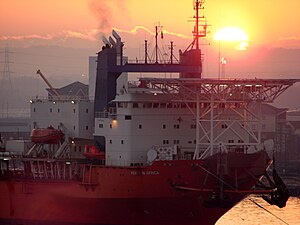 Peace in Africa during the 2006 refitting on the Tyne.
| |
| History | |
|---|---|
| Name |
|
| Owner |
|
| Port of registry |
|
| Builder | Verolme Shipyard Heusden, Netherlands[3] |
| Yard number | 994[3] |
| Laid down | 1982[4] |
| Launched | 12 November 1982[4] |
| Completed | May 1983[4] |
| Identification | |
| Status | In service[5] |
| General characteristics (as built)[3] | |
| Type | Heavy lift ship |
| Tonnage | |
| Length | |
| Beam | 24.20 m (79.4 ft) |
| Draught | 8.9 m (29.2 ft) |
| Depth | 15 m (49.2 ft) |
| Main engines | 2 × Stork-Werkspoor 6TM410[4] (2 × 3,128 kW[7]) |
| Auxiliary engines | 2 × 600 kW |
| Propulsion |
|
| Speed | 16 kn (30 km/h; 18 mph) |
| Capacity | 2,576 m2 (27,730 sq ft) cargo deck |
| Crew | 24 |
| General characteristics (1993)[8] | |
| Type | Cable ship |
| Displacement | 21,731 tons |
| Draught | 8.79 m (28.8 ft) |
| Propulsion | Azimuth thrusters (3 × 1,325 kW)[7] |
| Speed | 12.5 knots (23.2 km/h; 14.4 mph) |
| Range | 20,500 nautical miles (38,000 km; 23,600 mi) |
| Capacity | 10,000 tons of cable, 100 repeaters |
| Crew | 85[9] |
| General characteristics (2007)[5] | |
| Type | Dredger |
| Tonnage | |
| Crew | 68[10] |
The Mafuta is a diamond-mining ship owned and operated by De Beers in the western coast of South Africa.[11] Built in 1983 as Dock Express 20 for Dock Express Shipping (later Dockwise), the semisubmersible, multirole, heavy-lift vessel was converted to the world's largest cable layer in 1993.[9] In 2005, she was purchased by De Beers, and converted to a subsea diamond-mining ship by A&P Tyne over the course of 11 months. The ship's new name, Peace in Africa, may have implied that it was providing an alternative to blood diamonds.[6][12] In 2013, still under ownership of De Beers Marine Namibia, the vessel was renamed to MV Mafuta.
- ^ a b Dockwise. Tussen Hoek en Stad. Retrieved 2011-08-30
- ^ a b "Dock Express 20 (270429)". Port State Information Exchange. United States Coast Guard. Retrieved 20 May 2013.
- ^ a b c NB994 Dock Express 20 Archived 4 October 2011 at the Wayback Machine. Shipyard De Hoop. Retrieved 2011-08-30
- ^ a b c d DOCK EXPRESS 20 (Google Cache). 10 June 2005.
- ^ a b c "Peace in Africa (8125064)". Equasis. Ministry of Ecology, Sustainable Development and Energy. Retrieved 30 August 2011.
- ^ a b A&P wins Conversion Contract. MarineLink.com, 20 July 2005. Retrieved 2011-08-30
- ^ a b Sea State Alarm trial on cable ship Dock Express 20. Breeman Engineering and Services bv. Retrieved 2011-08-30
- ^ General features of optical fibre submarine cable systems Archived 7 October 2011 at the Wayback Machine. ITU-T Recommendation G.971, 04/2000. Retrieved 2011-08-30
- ^ a b Brown, Nicholas. Dutch ships lay Tyco cable. Seacoastonline.com, 21 June 2002. Retrieved 2011-08-30
- ^ Sharda (4 August 2011). "Mining Ship MV Peace in Africa : The Diamond Hunter". Marine Insight. Retrieved 29 August 2011.
- ^ Cite error: The named reference
miningweeklywas invoked but never defined (see the help page). - ^ Choo, Yoo Sang; Edelson, David N. (2008). Marine Operations Specialty Symposium. Research Publishing Services.